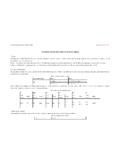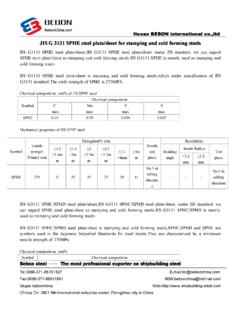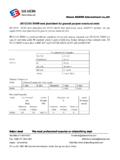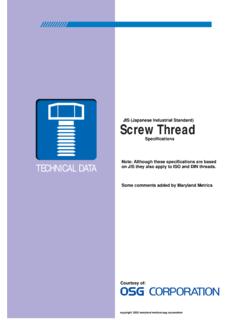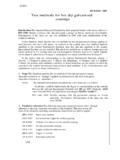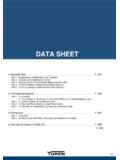Transcription of Antimicrobial products-Test for antimicrobial …
1 JIS. japanese . industrial . STANDARD. Translated and Published by japanese standards Association JIS Z 2801 :2000. Antimicrobial products-Test for Antimicrobial activity and efficacy ICS ; Descriptors : bacteriocide- activity determination, microbiological-resistance tests , biological hazards, culture techniques Reference number : JIS Z 2801: 2000 (E). 8S. japanese industrial STANDARD JIS Z 2801: 2000. Antimicrobial products . Test for Antimicrobial activity and efficacy Introduction This japanese industrial Standard has been prepared for standardizing the method for evaluating Antimicrobial efficacy in Antimicrobial products shown in the report of the Meeting on Life-Related Processed Products with New Functions ( Antimicrobial Products): December 1998 (so-called "Guidelines for Antimicrobial Products"). This standard specifies the Antimicrobial efficacy, a part of the perfor- mance considered to be important for Antimicrobial products, and the testing methods. Other information considered to be important for Antimicrobial products including safety, duration of Antimicrobial efficacy, and marking on the product shall be referred to in the "Guidelines for Antimicrobial Products".
2 1 Scope This Standard specifies the testing methods to evaluate Antimicrobial activity and Antimicrobial efficacy on bacteria on the surface of Antimicrobial products (including intermediate products). Remarks : The secondary effects of Antimicrobial efficacy, such as being anti- fungal and deodorizing efficacy, shall not be included in this Stan- dard. 2 Normative references The following standards contain provisions which, through reference in this Standard, constitute provisions of this Standard. The most recent editions of the standards indicated below (including amendments) shall be applied. JIS K 0950 Sterilized plastic petri dishes JIS K 0970 Piston operated micro-volumetric apparatus JIS K 3800 Class II biological safety cabinets JIS K 8101 Ethanol ( ). JIS K 8150 Sodium chloride JIS K 8180 Hydrochloric acid JIS K 8263 Agar JIS K 8576 Sodium hydroxide JIS K 9007 Potassium dihydrogenphosphate JIS K 9017 Dipotassium hydrogenphosphate JIS L 1902 Testing method for antibacterial of textiles JIS R 3505 Volumetric glassware 3 Definitions The definitions of the main terms used in this Standard are as follows: a) Antimicrobial The condition inhibiting the growth of bacteria on the surface of products.
3 Z 2801:2000. b) Antimicrobial finish A finishing treatment for Antimicrobial efficacy. c) Antimicrobial products Products treated with Antimicrobial finish. d) value of Antimicrobial activity This value shows the difference in the loga- rithmic value of viable cell counts between Antimicrobial products and untreated products after inoculation and incubation of bacteria. Informative reference : The value of bacteriostatic activity in JIS L 1902 ex- presses that of the Antimicrobial activity in this Stan- dard. e) Antimicrobial efficacy The efficacy of Antimicrobial products judged from the value of Antimicrobial activity . 4 Antimicrobial efficacy The value of Antimicrobial activity obtained by the testing methods of this Standard shall not be less than for the Antimicrobial efficacy of Antimicrobial products. Values of over may be applicable subject to the agreement between parties concerned with delivery. 5 Testing method Testing method for textile products The testing method for textile products shall be in accordance with 8 of JIS L 1902.
4 Testing method for plastic products, etc. This testing method is applicable to products other than textile products, such as plastic products, metal products, and ceramic products. Testing method may be used, however, for products judged to be suitable for using the testing method for textile products from the usage and form of the product . Bacteria to be used for the tests The species of bacteria to be used for the tests shall be as follows, and each bacteria shall be used for the test: a) Staphylococcus aureus b) Escherichia coli An example of the bacterial strain to be used for the tests is shown in Table 1. If the bacterial strain is contributed by other culture collection shown in Table 1, then it shall be obtained from member agencies of the World Federation of Culture Collection (WPCC) or the Japan Society of Culture Collection (JSCC) and the same strain as that shown in Table 1. Table 1 Bacterial strain to be used for the tests Bacteria Strain number Institution of culture collection Staphylococcus aureus ATCC6538P American Type Culture Collection FDA209P Food and Drug Administration IFO12732 Institute for Fermentation Escherichia coli ATCC8739 American Type Culture Collection IFO3972 Institute for Fermentation Z 2801:2000.
5 Chemicals, materials and apparatus The chemicals, materials and apparatus to be used in this Standard shall be given as follows, unless otherwise designated. Ethanol (C2H5OH) Class I as specified in JIS K 8102 or superior. Beef extract For microbial tests . Peptone For microbial tests . Sodium chloride (NaCl). Guaranteed reagent specified in JIS K 8150. Purified water Conforms to the reference of the 13th revised japanese Phar- macopoeia. Agar Guaranteed or superior reagent specified in JIS K 8263. Yeast extract For microbial tests . For Tryptone microbial tests . For Glucose microbial tests . For Casein peptone microbial tests . For Soybean peptone microbial tests . For Lecithin microbial tests . Nonionic surfactant Polyoxyethylene sorbitan monooleate [Polysorbate 80 (Tween 80)]. Potassium dihydrogenphosphate (KH2PC4). Guaranteed reagent specified in JIS K 9007. Dipotassium hydrogenphosphate (K2 HPC4). Guaranteed reagent specified in JIS K 9017. Sodium hydroxide (NaOH). Guaranteed reagent specified in JIS K 8576.
6 Hydrochloric acid (HC1). Guaranteed reagent specified in JIS E 8180. Cotton stopper, etc. OME cotton, otherwise silicone, metal, or morton stopper. Platinum loop With a loop of about 4 mm at the point. Dry-heat sterilizer Capable of keeping the temperature from 160 C to 180 C. Autoclave Capable of keeping at 121 C temperature and 103 kPa of pressure. Safety cabinet A performance conforming to or equivalent to JIS K 3800. Clean bench For microbial tests . Pipet Precision conforming to or equivalent to JIS K 0970 or the class A specified in JIS R 3505. Incubator Petri Capable of keeping the temperature 1 C. dish Made of glass with about 90 mm of inside diameter or con- forming to No. 90A or 90B as specified in JIS K 0950. Stomacher pouch For microbial tests . Z 2801:2000. Stomacher For microbial tests . Film A material not affecting microbial growth and that does not absorb water. The thickness is not specified, but one with good adherence shall be used. Sterilization method a) Dry-heat sterilization Put the object to be sterilized in a dry-heat sterilizer heated from 160 C to 180 C, and heat it for 30 min to 60 minO).
7 Note (J) After dry-heat sterilization is finished, when the cotton stopper or pack- aging paper is wet with water, do not use the apparatus referred to. b) High pressure steam sterilization Place water in an autoclave, and put the objects to be sterilized, which have been kept in a metal net basket, on a metal net shelf in the autoclave. Tighten the lid on the autoclave, heat it, and keep it at 121 C temperature and 103 kPa pressure for 15 min to 20 min. Stop heating it, naturally cool it to lower than 100 C, and open an exhaust valve to draw off the steam. Then take out the sterilized objects after opening the lid, and if necessary, cool them on a clean bench or in a safety cabinet. In order to keep the autoclave clean from contamination by incubation or processing chemicals, wash it with neutral detergent if needed, and rinse it sufficiently with water. c) Flame sterilization Put the objects to be sterilized into a gas or alcohol flame. For a platinum loop, red heat it sufficiently, and for a test tube, let it touch the flame for 2 s or 3 s.
8 D) Preparation of apparatus Wash well glassware such as test tubes or flasks with alkali or neutral detergent, rinse them sufficiently with water, dry them, and use them after either dry-heat sterilization or high nr* ssriri? ?te5im steril- ization. Culture medium, etc. The culture medium as shown below shall be used. A. commercially available one may be used if it is of the same composition. a) Nutrient broth Take g of beef extract, g of peptone, and g of sodium chloride in 1 000 ml of purified water or ion-exchanged water. Put them in a flask, mix them, dissolve them completely, and adjust the pH to to (25. C) using a sodium hydroxide solution or a hydrochloric acid solution. When the medium is used, take a part into a test tube, put in a cotton stopper, and sterilize it with high-pressure steam. If it is not used immediately after prepa- ration, then preserve it at 5 C to 10 C. Never use a nutrient broth that has been kept for one month or longer after preparation. b) Nutrient agar Take g of beef extract, g of peptone, g of sodium chloride, and g of agar powder in 1 000 ml of purified water or ion-exchanged water.
9 Put them in a flask, mix them, and heat in a boiling water bath to dis- solve them sufficiently. Adjust the pH to to (25 C) using a sodium hydroxide solution or a hydrochloric acid solution, put in a cotton stopper, and sterilize it with high pressure steam. If it is not used immediately after prepa- ration, then preserve it at 5 C to 10 C. Never use a nutrient agar kept for one month or longer after preparation. Z 2801:2000. c) Plate count agar Take g of yeast extract, g of tryptone, g of glucose, and g of agar powder in 1 000 ml of purified water or ion-exchanged water. Put them in a flask, mix them, and heat in a boiling water bath to dissolve them sufficiently. Adjust the pH to to (25 C) using a sodium hydroxide solution or a hydrochloric acid solution, put in a cotton stopper, and sterilize with high pressure steam. If it is not used immediately after preparation, then preserve it at 5 C to 10 C. Never use a plate count agar kept for one month or longer after preparation. d) Slant culture medium Pour 6 ml to 10 ml of nutrient agar b) which has been warmed to dissolve into a test tube.
10 Put in a cotton stopper and sterilize with high pressure steam. After sterilization, place the test tube in a clean room at a slant of about 15 to the horizontal plane, and solidify the contents. If it is not used immediately after preparation, then preserve it at 5 C to 10 C. If there is no condensed water, dissolve it, and employ it after solidifying it again. Never use a slant culture medium kept for one month or longer after preparation. e) SCDLP broth Take g of casein peptone, g of soybean peptone, g of sodium chloride, g of disodium hydrogen phosphate, g of glucose, and g of lecithin in 1 000 ml of purified water or ion-exchanged water. Put them in a flask, mix them, and add g of nonionic surfactant to dissolve them. Adjust the pH. to to (25 C) using a sodium hydroxide solution or a hydrochloric acid solution. When the medium is used, dispense it into test tubes or Erlen-meyer flasks, put in cotton stoppers and sterilize with high pressure steam. If it is not used immediately after preparation, then preserve it at 5 C to 10 C.


